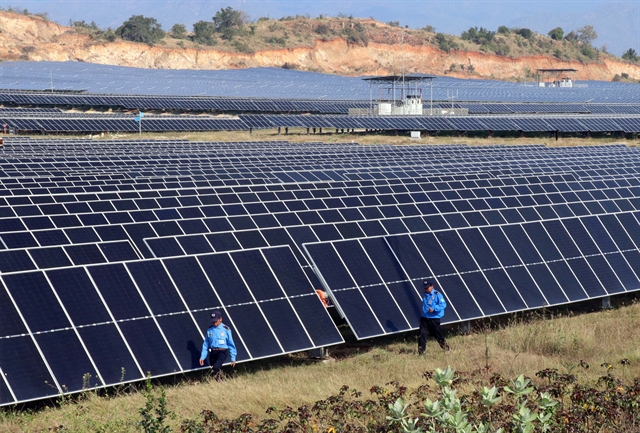 Society
Society


|
| A solar power project in the south-central province of Ninh Thuận. — VNA/VNS Photo |
HÀ NỘI — The Government Inspectorate issued a notice on Monday on its findings on the implementation of policies and laws in the management, implementation of planning, and investment in the construction of power projects under the National Power Development Plan VII (PDP7) and the revised PDP7, especially with regard to unlawful approval of too many solar power projects outside of planning.
The watchdog concludes that the management of planning implementation has achieved commendable results in increasing electricity production, positively contributing to socio-economic development, but it also points out a series of limitations, shortcomings and violations related to the adding of solar and renewable energy projects into existing plans.
According to the findings, the Ministry of Industry and Trade approved the addition of 114 solar projects with a total capacity of 4,166 MW to the provincial power planning, to be operational during the 2016-20 period. Of these, 92 projects with a total capacity of 3,194 MW were individually approved for supplementation into the power development planning of 23 provinces based on proposals from the people's committees of the provinces, which in turn, were based on proposals of project investors.
Fifteen of the 23 mentioned provinces had no prior solar power investment planning in their provincial power development planning, and the approval of these projects fell short of legal basis.
According to the Inspectorate, the total approved solar power capacity until 2020 in the revised PDP7 was 850 MW. However, the industry ministry recommended the Prime Minister separately approve the supplementation of 54 projects with a total capacity of 10,521 MW into the revised PDP7, based on localities' proposals. This approval was made without establishing a national solar power development plan until 2020, as required by Decision 11/2017 of the Prime Minister. Therefore, approving these 54 projects also lacked legal basis in terms of planning.
By approving 168 solar projects with a total capacity of 14,707 MW (17.3 times higher than the total approved capacity in the revised PDP7) – notably, the approval of 137 projects with a total capacity of 9,366 MW scheduled to operate during the 2016-20 period – the actual invested capacity of grid-connected solar power was 8,642 MW by the end of 2020, more than 10 times the approved capacity in the revised PDP7 (850 MW) and even over twice the planned capacity until 2025 (4,000 MW).
Moreover, rooftop solar power was also rapidly invested with a significant capacity of 7,864 MW, raising the total solar power capacity to 16,506 MW, 19.42 times higher than the approved capacity in the revised PDP7. This led to an increase in the percentage of solar power capacity according to the revised PDP7 from 1.4 per cent to 23.8 per cent.
The Government Inspectorate acknowledged that solar power production is highly predicated on weather conditions, with low stability, so investing in a large amount of grid-connected solar power, mainly concentrated in the low-load regions of the Central and Central Highlands provinces, requires a transmission plan to relieve capacity. However, the power grid did not receive timely and comprehensive investments at the same time, leading to a great imbalance between supply and the grid, the structure of power sources, and regions.
In addition to the Feed-in Tariff (FIT) paid to investors, the system cost increased by at least 5.5 cents/kWh.
There was a lack of synchronisation between the planning supplements for each project, the absence of an overall plan, and a lack of synchronisation with the accompanying power grid – with the construction schedule of power grid projects taking 3-5 years, much slower than the operation schedule of solar power. This leads to difficulties in operating the power system and causes potential overloads in the provinces of Ninh Thuận, Bình Thuận, Phú Yên, Gia Lai and Đắk Lắk, forcing power plants to reduce production.
The Government Inspectorate identified that allowing these violations to occur demonstrated lax management, signs of serious consequences due to negligence, as stipulated in Article 360 of the Penal Code of 2015.
The watchdog proposed that the Prime Minister assign the Ministry of Public Security to receive the findings, the documents and information on eight cases for review, investigation and handling according to regulations. The Security Investigation Agency from the ministry has accepted this proposal.
The findings have also been sent to the Party Central Inspection Committee to handle the offending officials under its jurisdiction. — VNS




